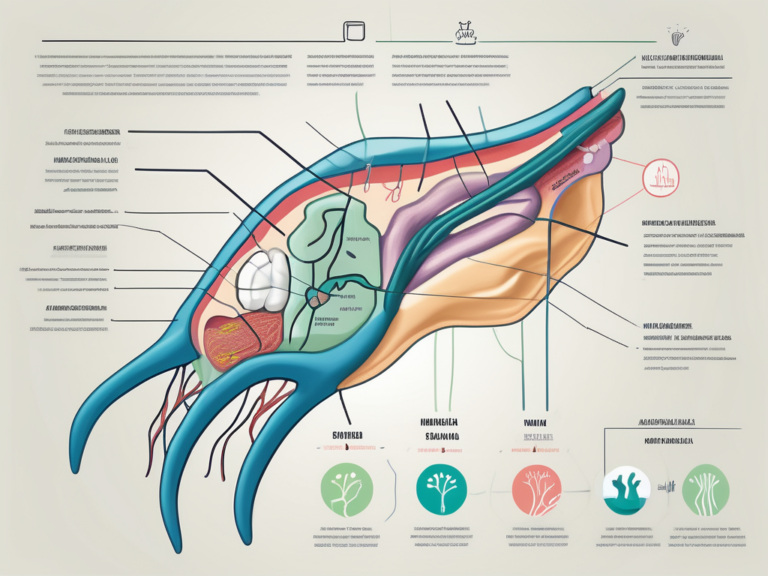Explaining Sympathetic Nerves to kids
Have you ever wondered why you feel your heart race when you’re scared or why your body tenses up when you’re nervous? Well, it’s all thanks to a special part of our body called the sympathetic nerves. The sympathetic nerves are part of the nervous system, which helps our body send messages from one part to another. In this article, we will dive into the fascinating world of sympathetic nerves and learn how they work.
Understanding the Nervous System
What is the Nervous System?
The nervous system is like the control center of our body. It helps us think, move, and feel things. Just like a telephone network, our nervous system uses messages to communicate with different parts of our body.
Imagine the nervous system as a complex web of communication channels, constantly transmitting and receiving signals to ensure the smooth functioning of our body. It is a sophisticated network that coordinates various bodily functions, from the simplest reflexes to complex cognitive processes.
The Role of the Nervous System in the Body
One of the most important roles of the nervous system is to keep our body in balance and help us respond to different situations. It has two main parts: the central nervous system (which includes the brain and spinal cord) and the peripheral nervous system (which includes the nerves that spread out from the spinal cord).
The central nervous system acts as the command center, processing information received from the body and sending out instructions in response. On the other hand, the peripheral nervous system serves as the link between the central nervous system and the rest of the body, relaying sensory information to the brain and carrying out motor commands from the brain to the muscles and organs.
Introduction to Sympathetic Nerves
What are Sympathetic Nerves?
Sympathetic nerves are a special group of nerves that are part of the peripheral nervous system. They are like messengers that help our body respond to different situations, especially when we feel scared, excited, or ready to take action.
These nerves are connected to various organs in our body, such as the heart, lungs, and blood vessels, allowing them to quickly transmit signals and coordinate responses in times of need.
The Function of Sympathetic Nerves
The main job of sympathetic nerves is to activate our body’s “fight or flight” response. This means that when we face a dangerous or stressful situation, they help our body get ready to either run away or fight back.
When the sympathetic nerves are activated, they cause several changes in the body, including increased heart rate, dilated pupils, and decreased digestion. These changes are all part of the body’s preparation to deal with the perceived threat effectively.
The Connection Between Sympathetic Nerves and Feelings
How Sympathetic Nerves Influence Emotions
Did you know that sympathetic nerves also play a role in the way we feel? When we experience strong emotions like being scared or excited, our sympathetic nerves get activated and send messages to different parts of our body, like the heart and muscles. This is why we may feel our heart racing or our body getting tense when we’re really happy or really scared!
Furthermore, sympathetic nerves are part of the autonomic nervous system, which controls involuntary bodily functions such as heart rate, digestion, and respiratory rate. The activation of sympathetic nerves can also lead to changes in these functions, impacting our overall physiological state. For example, during moments of intense emotion, the sympathetic nervous system may divert blood flow away from the digestive system and towards the muscles, preparing the body for action.
Sympathetic Nerves and the ‘Fight or Flight’ Response
The ‘fight or flight’ response is a natural instinct that helps us protect ourselves. When our body feels threatened or excited, sympathetic nerves release a chemical called adrenaline, which makes our heart beat faster, our breathing get quicker, and our muscles get ready for action. It’s like our body’s way of saying, “Hey, be prepared, something important is happening!”
Moreover, the activation of sympathetic nerves triggers the release of other stress hormones like cortisol, which helps to provide a burst of energy and sharpened focus during challenging situations. This coordinated response involving the sympathetic nervous system and various hormones is crucial for our survival and has been finely tuned through evolution to ensure our ability to effectively respond to threats in our environment.
Sympathetic Nerves and Physical Reactions
Understanding the intricate workings of sympathetic nerves can provide valuable insights into how our bodies respond to various stimuli. These nerves play a crucial role in regulating our physiological responses, particularly in moments of heightened emotions or stress.
How Sympathetic Nerves Affect Heart Rate
One fascinating thing about sympathetic nerves is their ability to control our heart rate. When these nerves get activated, they send messages to our heart, telling it to beat faster. This is why you might feel your heart pounding in your chest when you’re really scared or excited!
Furthermore, sympathetic nerves not only influence the speed at which our heart beats but also impact the strength of each heartbeat. This dual mechanism ensures that our cardiovascular system is adequately prepared to meet the increased demands placed on it during times of stress or excitement.
Sympathetic Nerves and Breathing
Did you know that sympathetic nerves also have an impact on our breathing? When we’re feeling nervous or scared, these nerves send signals to the muscles that help us breathe, making our breaths come quicker and shallower. It’s like our body is getting ready to take in more oxygen so we can face whatever challenge lies ahead!
Moreover, the coordination between sympathetic nerves and the respiratory system extends beyond just increasing the rate of breathing. These nerves also play a role in optimizing the distribution of oxygen to different tissues in the body, ensuring that vital organs receive an adequate oxygen supply during times of heightened physiological demand.
Fun Facts About Sympathetic Nerves
Interesting Things to Know About Sympathetic Nerves
Here are a few fun facts to amaze your friends with:
- Our sympathetic nerves work really fast. They can send messages from our brain to our body in the blink of an eye!
- Sympathetic nerves not only help us respond to danger, but they also play a role in everyday activities like digestion and regulating body temperature.
- Sometimes sympathetic nerves can get a little too excited, causing us to blush or sweat more than usual. It’s like they’re trying to tell the world how we feel!
Did you know that sympathetic nerves are part of the autonomic nervous system, which controls involuntary bodily functions like heart rate, breathing, and digestion? These nerves work alongside the parasympathetic nerves to maintain balance in the body, ensuring that everything runs smoothly.
Furthermore, sympathetic nerves release a neurotransmitter called norepinephrine, which helps in the fight-or-flight response. This response prepares the body to react quickly in dangerous situations by increasing heart rate, dilating airways, and redirecting blood flow to vital organs.
Myths and Truths About Sympathetic Nerves
There are many myths and misconceptions about sympathetic nerves. Let’s uncover the truths behind a few common ones:
- Myth: Sympathetic nerves are only active when we’re scared or nervous.
- Truth: While sympathetic nerves do play a big role in our response to fear and stress, they’re also active in other situations like when we’re excited, happy, or even during exercise.
- Myth: Sympathetic nerves are always a bad thing.
- Truth: Sympathetic nerves are a normal and important part of our body’s response to different situations. It’s not about good or bad; it’s about helping our body react appropriately.
Simplifying Sympathetic Nerves for Kids
Easy Ways to Explain Sympathetic Nerves
Explaining complex concepts to kids can be a challenge, but here are a few simple ways to help them understand sympathetic nerves:
- Think of sympathetic nerves as messengers that help your body get ready for action.
- Imagine that your body has a special superhero power that helps you run faster or be stronger when you need it.
- Tell a story where sympathetic nerves are the heroes, helping a character face their fears and accomplish amazing things!
Understanding sympathetic nerves is like unlocking a secret power within your body. These nerves are like a team of superheroes, ready to jump into action whenever you need them. Just like how a superhero saves the day, sympathetic nerves help your body respond to challenges and adventures.
Making Sympathetic Nerves Understandable for Children
When talking to kids about sympathetic nerves, it’s important to use words and examples that they can relate to. You can use drawings, games, or even role-playing to engage their imagination and make the topic more enjoyable and understandable.
So next time you feel your heart race or your body tingle with excitement, remember that it’s your sympathetic nerves at work, helping you face challenges and embrace new experiences. Understanding how our body works is like having a superpower of knowledge, so keep exploring and learning new things!
By learning about sympathetic nerves, you’re gaining insight into the incredible ways your body responds to different situations. Just like how a brave knight protects the kingdom, your sympathetic nerves are always there to support you in your daily adventures. So, embrace the wonder of your body’s inner workings and appreciate the amazing mechanisms that keep you going!






